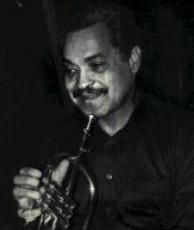
Interview of 1988
Memories of Art Farmer
Not Quite Jazz
Ron Simmonds reports
When Dizzy Gillespieís first big band recordings began to arrive in Britain
the drummer Leon Roy managed to get copies of all his scores. Leon had
a regular weekly big band jazz night in the Paramount, Tottenham Court
Road, London and we used Dizzyís library. Someone had transcribed his
solos faithfully, note for note, and I used to play them. I even played
one of them with Vic Lewis later on that got me voted into a popularity
poll. Kenny Baker was at the top, and I was right at the bottom.
When I mentioned this to Diz some years later he said that he had looked at the transcriptions and he couldnít play them. He couldnít even read them.
When Dizzy played those solos he was playing jazz, straight from the head. Or, more accurately, straight from the soul. When I played them, was I playing jazz? Of course I wasnít. However much I tried to insert style and feeling into them I was still only reading what Dizzy had conjured up on the spur of the moment. Spectacular they may have sounded, and they might have fooled some of the listeners, but whatever I did it still didnít sound like Dizzy.
On some old tunes you are expected to play the original solos. Over the years Iíve had many people coming up to thank me for playing some of the solos from the Glenn Miller records, especially the one in String of Pearls. How could you better that one? Itís beautiful, and most people play it note for note, but however much they might try, they will never manage to make it sound like Bobby Hackett. Copied to perfection, maybe, but reading somebody elseís solo is not quite jazz.
When we played with Peter Herbolzheimerís Rhythm Combination & Brass, in Ronnie Scottís Club in 1974, Art Farmer played a solo on Blues in My Shoes. Itís on the record we made there called Scenes. As it was so exquisitely put together I thought I might let you see part of it, as far as I could capture it on paper. The solo is based on a variation of the 12-bar blues. If you play it back and listen closely youíll hear the altered chords in the second, eleventh and twelfth bars of the sequence.
It isnít too difficult and most players could probably manage it. The solo wouldnít work on any other instrument but the flugelhorn, though. From bars 1 to 24 Art almost sounds as if he is throwing it away.
He growls, whispers and flusters, pouring soul into the notes. Then, on bar 25, he explodes into action.
Try it. Donít expect to sound like Art, but youíll see what can still be done with the common old 12 bar blues in Bb.
And thatís jazz.
Copyright © 2000 Ron Simmonds. All Rights Reserved